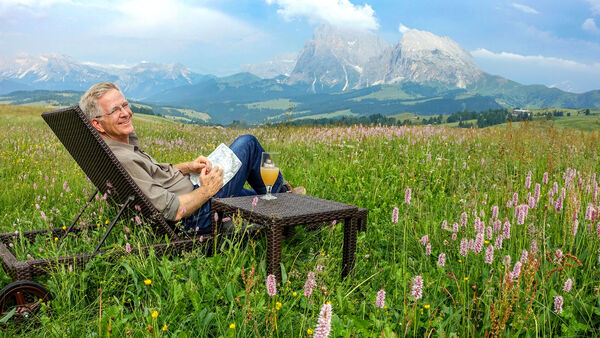Stretching Out in the Italian Alps
By Rick StevesLeaning back into my lounge chair, I relaxed as if I were at the beach — but I was high in Italy's Alps, the Dolomites. Europe's largest high alpine meadow — speckled with wildflowers and manicured by munching goats and cows — spread out like a sea before me. And in the distance, stark limestone peaks towered — snow-dusted and bold against the blue sky. These mountains differ from the rest of the Alps because of their dominant rock type — dolomite — which forms sheer vertical walls of white, gray, and pink rising abruptly from green valleys and meadows.
My soundtrack was the happy laughter of Italian children delighted by a mini-petting zoo filled with alpine critters. A few yards away their parents sipped wine on the veranda of their chalet guesthouse — thoroughly reveling in that Italian dolce far niente (sweetness of doing nothing).
The meadow, the Seiser Alm ("Alpe di Siusi" in Italian), seems to float high above the city of Bolzano, separating two of the most famous Dolomite ski-resort valleys (Val di Fassa and Val Gardena). Measuring three miles by seven and a half miles, and soaring 6,500 feet high, the Seiser Alm is dotted by farm huts and happy hikers enjoying gentle trails.
The Langkofel mountains at the head of the meadow provide a storybook Dolomite backdrop, while the bold, spooky outcropping of Schlern stands gazing into the haze of the Italian peninsula. Not surprisingly, the Schlern, looking like a devilish Winged Victory, gave ancient peoples enough willies to spawn legends of supernatural forces. Fear of the Schlern witch, today's tourist-brochure mascot, was the cause of many a broom-riding medieval townswoman's fiery death.
A natural preserve, the alpine meadow is virtually car-free. A cable car whisks visitors up to the park from the valley below. Within the park, buses shuttle hikers to and from key points along the tiny road all the way to the foot of the postcard-dramatic Langkofel peaks. Meadow walks are ideal for flower lovers and strollers, while multiple chairlifts serve as springboards for more dramatic and demanding hikes. Mountain bikes are easy to rent, welcome on many lifts, and permitted on the meadow's country lanes.
The Seiser Alm is my recommended one-stop look at the Dolomites because of its easy accessibility to those with or without cars, the variety of walks and hikes, the quintessential Dolomite views, and the charm of neighboring Kastelruth — known to Italian speakers as "Castelrotto" — as a home base.
While the Dolomites are peaceful now, during World War I the front line between the Italian and Austrian forces ran through these mountains, and many paths were cut into the range for military use. Today mountaineers can follow a network of metal rungs, cables, and ladders — what Italians call a via ferrata. One famous wartime trail is the Strada delle Gallerie (Road of Tunnels), which passes through 52 tunnels.
This hard-fought history has left this northeastern corner of Italy bicultural and bilingual, with der emphasis on the Deutsch. In the Middle Ages, the region faced north, part of the Holy Roman Empire. Later it was firmly in the Austrian Habsburg realm. (Austria's most mountainous region, Tirol, takes its name from a village that is now actually in Italy.) After Austria lost World War I, its "Südtirol" (South Tirol) became Italy's "Alto Adige." Mussolini did what he could to Italianize the region, including giving each town an Italian name.
But most locals still speak German first (especially those who live up above the valley floor), and many wish they were still Austrian — or at least feel a closer bond with their Germanic ancestors than with their Italian countrymen. Most have a working knowledge of Italian, but they watch German-language TV, read newspapers auf Deutsch, and live in Tirolean-looking villages. The government has wooed cranky German-speaking locals with economic breaks that make this one of Italy's richest areas (as local prices attest). Today, signs and literature in the autonomous province of Südtirol/Alto Adige are in both languages.
The best time to visit — when everything is open and booming, but also at full-price and crowded — is from mid-July through September. The months in between can be pretty dreary. During the spring and fall low season, the most exciting trails are still under snow, and the mountain lifts are shut down. Most mountain huts and budget accommodations are closed, as the locals are more concerned with preparing for another boom season than catering to the stray off-season tourist.
Whether you experience the Dolomites with your hand on a walking stick, a ski pole, or an aperitivo while mountain-gazing from a café, it's easy to enjoy this Germanic eddy in the whirlpool of Italy.


